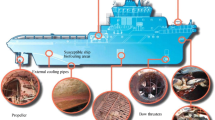Abstract
This paper experimentally investigates the influence on the propulsive performance by the difference in the fin shape of a robotic manta. Five kinds of fin shapes, i.e., a rectangle, a triangle, a trapezoid, and two right triangles, are used in experiment to measure the forward speed of the robot, where two types of right triangle are discriminated, depending on the arrangement of the right angle part and each fin area is assumed to be approximately equal, and the number of fin rays is the same at all the fins. It is proved that a significant difference in propulsive speed arises depending on the difference in the fin shape. Some experiments are additionally conducted to examine the influence on the propulsive speed and its efficiency, due to the parameter change of a progressive wave in the fin.











Similar content being viewed by others
References
Palmisano JS, Geder JD, Pruessner MD et al. (2013), Power and thrust comparison of bio-mimetic pectoral fins with traditional propeller-based thrusters. In: Proc. of 18th International Symposium on Unmanned Untethered Submersible Technology (UUST), Portsmouth, NH, USA, August 11–14, pp 143–150
Palmisano JS, Geder JD, Ramamurti R et al (2012) Robotic pectoral fin thrust vectoring using weighted gait combinations. Appl Bion Biomech 9:333–345
Low KH (2007) Design, development and locomotion control of bio-fish robot with undulating anal fins. Int J Robot Autom 22:88–99
Zhang Y, He J, Low KH (2012) Parametric study of an underwater finned propulsor inspired by bluespotted ray. J Bionic Eng 9:166–176
Suzumori K, Endo S, Kanda T et al (2007) A bending pneumatic rubber actuator realizing soft-bodied manta swimming robot. In: Proc. of IEEE Int. Conf. on Robotics and Automation, Roma, Italy, April 10–14, pp 4975–4980
Moored KW, Bart-Smith H (2008) Myliobatoid-inspired flapping fin: qualitative flow structure. Virginia Space Grant Consortium Student Research Conference, Old Dominion University, Norfolk, Virginia, April 21, 2008, pp 1–7
Cai Y, Bi S, Zheng L (2010) Design and experiments of a robotic fish imitating cow-nosed ray. J Bionic Eng 7:120–126
Yang SB, Han XY, Zhang DB et al (2008) Design and development of a new kind of pectoral oscillation propulsion robot fish (in Chinese). Robot 30(6):508–515
Yang SB, Qui J, Han XY (2009) Kinematics and modelling and experiments of pectoral oscillation propulsion robotic fish. J Bionic Eng 6(2):174–179
Zhou C, Low KH (2012) Design and locomotion control of a biomimetic underwater vehicle with fin propulsion. IEEE/ASME Trans Mechatron 17(1):25–35
Ikeda M, Hikasa S, Watanabe K et al (2013) A brief review of latest fish robots. In: Proc. of 2nd International conference on electrical, control and computer engineering (InECCE2013), Pahang, Malaysia, August 27–28, 2013, pp 285–289
Seo K, Chung SJ, Slotine JJE (2010) CPG-based control of a turtle-like underwater vehicle. Auton Robots 28(3):247–269
Chi W, Low KH (2012) Review and fin structure design for robotic manta ray (Roman IV). J Robot Mechatron 24(4):620–628
Ikeda M, Yamamoto Y, Yoshinaka et al (2012) Propulsion control for a manta robot with neural oscillators. In: Proc. of the SICE Annual Conference 2012, Akita University, Akita, Japan, August 20–23, 2012, pp 85–88
Ikeda M, Watanabe K, Nagai I (2012), Propulsion movement control using CPG for a manta robot. In: Proc. of Joint 6th International Conference on Soft Computing and Intelligent Systems and 13th International Symposium on Advanced Intelligent Systems (SCIS-ISIS 2012), Kobe International Conference Center, Kobe, Japan, November 20–24, 2012, pp 755–758
Ikeda M, Hikasa S, Watanabe K et al (2013) Propulsive force analysis of a pectoral fin for rajiform type fish robots from fluid dynamic aspects. In: Proc. of the 18th Int. symposium on artificial life and robotics (AROB 18th ’13), Daejeon, Korea, January 30–February 1, 2013, pp 65–68
Matsuoka K (1987) Mechanisms of frequency and pattern control in the neural rhythm generators. Biol Cybern 56(5–6):345–353
Author information
Authors and Affiliations
Corresponding author
Additional information
This work was presented in part at the 20th International Symposium on Artificial Life and Robotics, Beppu, Oita, January 21–23, 2015.
About this article
Cite this article
Ikeda, M., Mikuriya, K., Watanabe, K. et al. Influence on the propulsive performance due to the difference in the fin shape of a robotic manta. Artif Life Robotics 22, 276–282 (2017). https://doi.org/10.1007/s10015-017-0351-8
Received:
Accepted:
Published:
Issue Date:
DOI: https://doi.org/10.1007/s10015-017-0351-8




